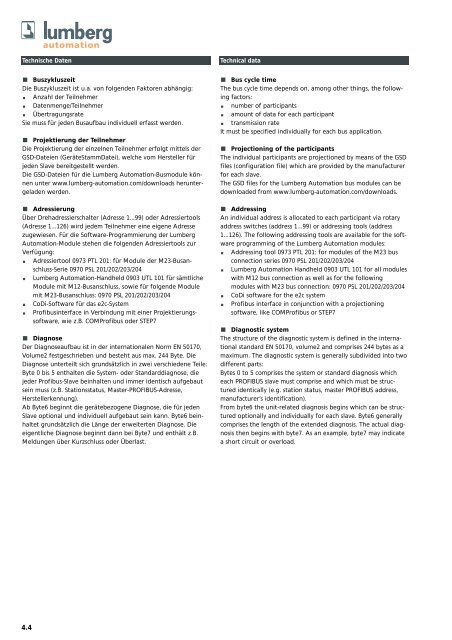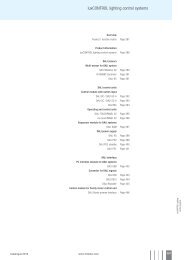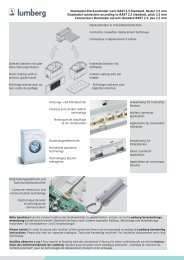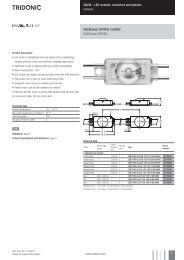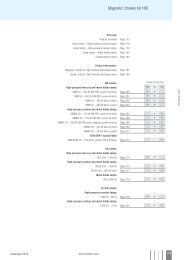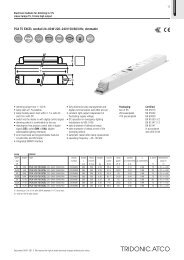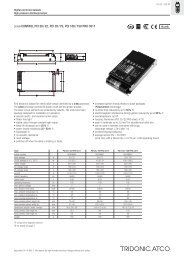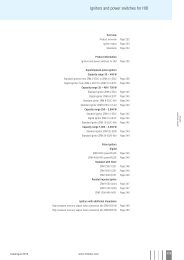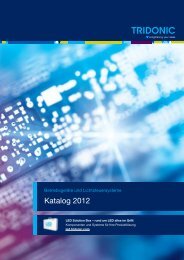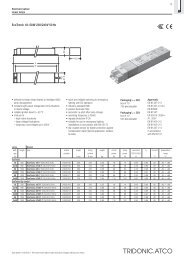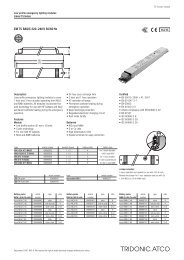- Seite 1 und 2:
Steckverbinder und Komponenten für
- Seite 3 und 4:
Aktor-/Sensor-Verteiler Actuator/se
- Seite 5 und 6:
AS-Interface (Actuator-Sensor-Inter
- Seite 7 und 8:
Die neue AS-Interface-Spezifikation
- Seite 9 und 10:
0910 ASL 501 AS-Interface-Modul mit
- Seite 11 und 12:
0913 ATL 003 Adressiergerät Handhe
- Seite 13 und 14:
0910 ASL 501 Version 2.1 - 4 In AS-
- Seite 15 und 16:
0910 ASL 409 Version 2.1 - 4 In AS-
- Seite 17 und 18:
0910 ASL 132 4 In - M12 AS-Interfac
- Seite 19 und 20:
0910 ASL 412 Version 2.1 - 8 In AS-
- Seite 21 und 22:
0910 ASL 403 4 Out AS-Interface-Fla
- Seite 23 und 24:
0910 ASL 133 4 Out - M12 AS-Interfa
- Seite 25 und 26:
0910 ASL 419 Version 2.1 - 8 Out AS
- Seite 27 und 28:
0910 ASL 410 Version 2.1 - 2 In / 2
- Seite 29 und 30:
0910 ASL 134 2 In / 2 Out - M12 AS-
- Seite 31 und 32: 0910 ASL 414 Version 2.1 - 4 In / 3
- Seite 33 und 34: 0910 ASL 408 Version 2.1 - 4 In / 4
- Seite 35 und 36: 0910 ASL 135 4 In / 4 Out - M12 AS-
- Seite 37 und 38: 0910 ASL 424 Version 2.1 - 4 In / 4
- Seite 39 und 40: 0910 ASL 425 Version 2.1 - 4 In / 4
- Seite 41 und 42: 0911 ANC 002 AS-Interface-Passiv-Mo
- Seite 43 und 44: 0911 ANC 101 AS-Interface-Abzweig z
- Seite 45 und 46: 0911 ANC 407/... M 0911 ANC 410/...
- Seite 47 und 48: 0913 ATL 003 Adressiergerät zur Ad
- Seite 49 und 50: 0915 034 101/... M AS-Interface-Ver
- Seite 51 und 52: 0911 ANC 409 Abschluss-Dichtung fü
- Seite 53 und 54: INTERBUS ist ein international eing
- Seite 55 und 56: Technische Daten Technical data Zul
- Seite 57 und 58: 8 In 0950 ISL 205 Interbus-Teilnehm
- Seite 59 und 60: 0950 ISL 205 8 In Interbus-Teilnehm
- Seite 61 und 62: 0950 ISL 202 8 In Interbus-Teilnehm
- Seite 63 und 64: 0950 ISL 204 16 In Interbus-Teilneh
- Seite 65 und 66: 0950 ISL 201 8 Out Interbus-Teilneh
- Seite 67 und 68: 0950 ISL 207 8 Out Interbus-Teilneh
- Seite 69 und 70: 0950 ISL 203 8 In / 4 Out Interbus-
- Seite 71 und 72: 0950 ISL 209 8 In / 4 Out Interbus-
- Seite 73 und 74: 0955 283 201/... M 0955 283 202/...
- Seite 75 und 76: RSU 6-RKU A 6-203/0,6 M RKU A 6-203
- Seite 77 und 78: Anschlusshinweis 0950 ISL 205: Inte
- Seite 79 und 80: 3.28
- Seite 81: PROFIBUS Der PROFIBUS (Process Fiel
- Seite 85 und 86: 0970 PSL 651 Profibus-DP-Teilnehmer
- Seite 87 und 88: 0975 254... - 0975 202... - RKU...
- Seite 89 und 90: 0970 PSL 651 8 In Profibus-DP-Teiln
- Seite 91 und 92: 0970 PSL 650 8 In / 8 Out universal
- Seite 93 und 94: 0970 PSL 114 8 In Profibus-DP-Teiln
- Seite 95 und 96: 0970 PSL 213 8 In Profibus-DP-Teiln
- Seite 97 und 98: 0970 PSL 701 16 In Profibus-DP-Teil
- Seite 99 und 100: 0970 PSL 111 16 In Profibus-DP-Teil
- Seite 101 und 102: 0970 PSL 209 16 In Profibus-DP-Teil
- Seite 103 und 104: 0970 PSL 112 8 Out Profibus-DP-Teil
- Seite 105 und 106: 0970 PSL 210 8 Out Profibus-DP-Teil
- Seite 107 und 108: 0970 PSL 124 16 Out Profibus-DP-Tei
- Seite 109 und 110: 0970 PSL 215 16 Out Profibus-DP-Tei
- Seite 111 und 112: 0970 PSL 113 8 In / 4 Out Profibus-
- Seite 113 und 114: 0970 PSL 211 8 In / 4 Out Profibus-
- Seite 115 und 116: 0970 PSL 123 8 In / 8 Out Profibus-
- Seite 117 und 118: 0970 PSL 214 8 In / 8 Out Profibus-
- Seite 119 und 120: 0970 PSL 700 16 In / 16 Out univers
- Seite 121 und 122: 0903 UTL 101 Adressiergerät für B
- Seite 123 und 124: 0973 PTL 201 0973 PTL 202 Adressier
- Seite 125 und 126: 0975 254 101/... M 0975 254 102/...
- Seite 127 und 128: RKU E 6-203/... M Spannungsversorgu
- Seite 129 und 130: 0905 204 309/0,6 M 0905 204 308/...
- Seite 131 und 132: Anschlusshinweis: Profibus M23-Modu
- Seite 133 und 134:
CANopen CANopen ist ein offenes Kom
- Seite 135 und 136:
Technische Daten Buszykluszeit Die
- Seite 137 und 138:
0930 CSL 108 - 0930 CSL 109 CANopen
- Seite 139 und 140:
0930 CSL 108 16 In (p) CANopen-Teil
- Seite 141 und 142:
0930 CSL 109 16 In (n) CANopen-Teil
- Seite 143 und 144:
0930 CSL 107 8 Out CANopen-Teilnehm
- Seite 145 und 146:
0930 CSL 114 16 Out CANopen-Teilneh
- Seite 147 und 148:
0930 CSL 113 8 In / 8 Out CANopen-T
- Seite 149 und 150:
0935 253 103/... M 0935 253 104/...
- Seite 151 und 152:
0935 253 301/... M 0935 253 302/...
- Seite 153 und 154:
0905 203 302/0,6 M 0905 203 301/...
- Seite 155 und 156:
Anschlusshinweis: CANopen M12-Modul
- Seite 157 und 158:
DeviceNet TM ist ein Feldbussystem
- Seite 159 und 160:
Technische Daten Buszykluszeit Die
- Seite 161 und 162:
0930 DSL 651 DeviceNet-Teilnehmer m
- Seite 163 und 164:
0930 DSL 651 8 In DeviceNet-Teilneh
- Seite 165 und 166:
0930 DSL 650 8 In / 8 Out universal
- Seite 167 und 168:
0930 DSL 701 16 In DeviceNet-Teilne
- Seite 169 und 170:
0930 DSL 108 16 In (p) DeviceNet-Te
- Seite 171 und 172:
0930 DSL 109 16 In (n) DeviceNet-Te
- Seite 173 und 174:
0930 DSL 312 16 In (p) DeviceNet-Te
- Seite 175 und 176:
0930 DSL 313 16 In (n) DeviceNet-Te
- Seite 177 und 178:
0930 DSL 107 8 Out DeviceNet-Teilne
- Seite 179 und 180:
0930 DSL 311 8 Out DeviceNet-Teilne
- Seite 181 und 182:
0930 DSL 114 16 Out DeviceNet-Teiln
- Seite 183 und 184:
0930 DSL 315 16 Out DeviceNet-Teiln
- Seite 185 und 186:
0930 DSL 113 8 In / 8 Out DeviceNet
- Seite 187 und 188:
0930 DSL 314 8 In / 8 Out DeviceNet
- Seite 189 und 190:
0930 DSL 700 16 In / 16 Out univers
- Seite 191 und 192:
0931 DNC 301 Passive DeviceNet-Vert
- Seite 193 und 194:
0935 253 103/... M 0935 253 104/...
- Seite 195 und 196:
0935 253 301/... M 0935 253 302/...
- Seite 197 und 198:
0905 356 312/0,6 M 0905 356 311/...
- Seite 199 und 200:
Anschlusshinweis: DeviceNet M12-Mod
- Seite 201 und 202:
6.46
- Seite 203 und 204:
Ethernet für die industrielle Auto
- Seite 205 und 206:
Verwendung von Hubs/Switches Bei Ve
- Seite 207 und 208:
0982 EEC 100 Ethernet-Switch, IP 67
- Seite 209 und 210:
0981 ENC 100 RJ45-/M12-Adapter, Ein
- Seite 211 und 212:
0985 342 100/... M Industrial Ether
- Seite 213 und 214:
e2c 67 - das zentrale, busfähige I
- Seite 215 und 216:
Elektrische Funktionsprüfung Elect
- Seite 217 und 218:
0941 UNC 010 - 0941 UNC 020 - 0941
- Seite 219 und 220:
0947 USW 100 e2c 67 Konfigurationst
- Seite 221 und 222:
0941 UNC 010 0941 UNC 020 e2c 67 Ba
- Seite 223 und 224:
0941 PNC 101 0941 PNC 103 e2c 67 Pl
- Seite 225 und 226:
0941 PNC 201 e2c 67 PlugBox Profibu
- Seite 227 und 228:
0941 DNC 101 0941 DNC 301 e2c 67 Pl
- Seite 229 und 230:
0940 PSL 001 e2c 67 BusHead Profibu
- Seite 231 und 232:
0940 ISL 001 e2c 67 BusHead Interbu
- Seite 233 und 234:
0940 DSL 001 e2c 67 BusHead DeviceN
- Seite 235 und 236:
0942 UEM 011 4 In e2c 67 I/O-Modul
- Seite 237 und 238:
0942 UEM 102 4 In e2c 67 I/O-Modul
- Seite 239 und 240:
0942 UEM 012 8 In e2c 67 I/O-Modul
- Seite 241 und 242:
0942 UEM 014 8 In 0942 UEM 019 8 In
- Seite 243 und 244:
0942 UEM 032 4 In e2c 67 I/O-Modul
- Seite 245 und 246:
0942 UEM 034 4 In e2c 67 I/O-Modul
- Seite 247 und 248:
0942 UEM 021 4 Out 0942 UEM 026 4 O
- Seite 249 und 250:
0942 UEM 022 8 Out 0942 UEM 201 8 O
- Seite 251 und 252:
0942 UEM 205 8 Out e2c 67 I/O-Modul
- Seite 253 und 254:
0942 UEM 027 8 Out 0942 UEM 203 16
- Seite 255 und 256:
0942 UEM 040 2 Out 0942 UEM 041 2 O
- Seite 257 und 258:
0942 UEM 024 4 In / 4 Out 0942 UEM
- Seite 259 und 260:
0941 UNC 100 e2c 67 Abdeckbox für
- Seite 261 und 262:
Anschlusshinweis 0941 PNC 101: e2c
- Seite 263 und 264:
Anschlusshinweis 0941 PNC 201: e2c
- Seite 265 und 266:
Anschlusshinweis 0941 DNC 101: e2c
- Seite 267 und 268:
8.56
- Seite 269 und 270:
e2c 20 - das IP 20 Verteilersystem
- Seite 271 und 272:
0920 PSL 001 - 0920 CSL 001 - 0920
- Seite 273 und 274:
0921 UEC 502 - 0921 UEC 503 - 0921
- Seite 275 und 276:
0920 PSL 001 0920 CSL 001 e2c 20 Bu
- Seite 277 und 278:
0922 UEM 011 0922 UEM 012 0922 UEM
- Seite 279 und 280:
0922 UEM 034 0922 UEM 035 e2c 20 I/
- Seite 281 und 282:
0922 UEM 030 0922 UEM 032 0922 UEM
- Seite 283 und 284:
0922 UEM 050 e2c 20 I/O-Modul mit 2
- Seite 285 und 286:
0922 UEM 020 0922 UEM 021 0922 UEM
- Seite 287 und 288:
0922 UEM 040 0922 UEM 042 0922 UEM
- Seite 289 und 290:
0921 UEC 500 0921 UEC 502 0921 UEC
- Seite 291 und 292:
0921 UEC 001 e2c 20 Endkappe e2c 20
- Seite 293 und 294:
Aktor-/Sensor-Verteiler für die le
- Seite 295 und 296:
ASBSM.../LED Steckbarer Miniatur-Ak
- Seite 297 und 298:
M12 - M23 FIXCON / M12 FIXCON / M12
- Seite 299 und 300:
ASBSM.../LED Steckbarer Miniatur-Ak
- Seite 301 und 302:
ASBM.../LED Miniatur-Aktor-/Sensor-
- Seite 303 und 304:
SBS 4/LED Steckbarer Miniatur-Senso
- Seite 305 und 306:
ASNBV 8/LED Aktor-/Sensor-Verteiler
- Seite 307 und 308:
ASNBL 8/LED Aktor-/Sensor-Verteiler
- Seite 309 und 310:
ASB Aktor-/Sensor-Verteiler, 4-, 6-
- Seite 311 und 312:
ASB.../LED Aktor-/Sensor-Verteiler
- Seite 313 und 314:
ASB 8/LED 5-4/1,5 M Aktor-/Sensor-V
- Seite 315 und 316:
ASBV Aktor-/Sensor-Verteiler, 4-, 6
- Seite 317 und 318:
ASBV.../LED Aktor-/Sensor-Verteiler
- Seite 319 und 320:
ASBS Steckbarer Aktor-/Sensor-Verte
- Seite 321 und 322:
ASBS.../LED Steckbarer Aktor-/Senso
- Seite 323 und 324:
ASBS 8/LED 5-4/4E4A Steckbarer Akto
- Seite 325 und 326:
ASBSV Steckbarer Aktor-/Sensor-Vert
- Seite 327 und 328:
ASBSV.../LED Steckbarer Aktor-/Sens
- Seite 329 und 330:
ASBSVD 8/LED W5 Steckbarer Aktor-/S
- Seite 331 und 332:
ASBSVB 8/LED 4 + PE ASBSB 8/LED.../
- Seite 333 und 334:
ASBSVC 8/LED 4 + PE ASBSC 8/LED.../
- Seite 335 und 336:
RSWU 12-ASB 8/LED RSWU 12-SB 8/LED
- Seite 337 und 338:
10.46
- Seite 339 und 340:
Effizient und flexibel verdrahten m
- Seite 341 und 342:
ZV 2 Doppelkupplung (2-fach-Verteil
- Seite 343 und 344:
ZV 2 Doppelkupplung (2-fach-Verteil
- Seite 345 und 346:
ASBS 2 M8 ASBS 2 M12 ASBSA 2 M12 T-
- Seite 347 und 348:
ASBS 2 M8-90 ASBS 2 M12...-90 T-Ver
- Seite 349 und 350:
FASBS 2 M12 T-Verteiler inkl. Befes
- Seite 351 und 352:
0906 UTP 101 0906 UTP 301 T-Verteil
- Seite 353 und 354:
0906 UTP 302 0906 UTP 303 T-Verteil
- Seite 355 und 356:
3 2 4 6 1 7 5 2 1 2 1 0 0906 UTP 20
- Seite 357 und 358:
0906 UTP 203 0906 UTP 204 T-Verteil
- Seite 359 und 360:
FSA 5 FVB 5 Sensoradapter, FIXCON-S
- Seite 361 und 362:
VAD M12 1A-VAD 1A-1-3 Doppelmagnetv
- Seite 363 und 364:
VAD 3C-4-1 VAD 1A...M12 Steckverbin
- Seite 365 und 366:
VAD 1A...M8 VB 1A...M8 Ventiladapte
- Seite 367 und 368:
11.30
- Seite 369 und 370:
Ende offen: Anschlussleitungen für
- Seite 371 und 372:
RSMV - RSMWV Aktor-/Sensor-Anschlus
- Seite 373 und 374:
VAD 3C Sensor-Anschlussleitung, Ste
- Seite 375 und 376:
RSMV RSMWV Aktor-/Sensor-Anschlussl
- Seite 377 und 378:
FST Aktor-/Sensor-Anschlussleitung,
- Seite 379 und 380:
RST Aktor-/Sensor-Anschlussleitung,
- Seite 381 und 382:
RSTS Aktor-/Sensor-Anschlussleitung
- Seite 383 und 384:
PRST Aktor-/Sensor-Anschlussleitung
- Seite 385 und 386:
RS RSW Aktor-/Sensor-Anschlussleitu
- Seite 387 und 388:
RSUF RSWUF Anschlussleitung, M23-St
- Seite 389 und 390:
RKD RKDW Aktor-/Sensor-Anschlusslei
- Seite 391 und 392:
RKM RKMW Aktor-/Sensor-Anschlusslei
- Seite 393 und 394:
RKMV RKMWV Aktor-/Sensor-Anschlussl
- Seite 395 und 396:
RKMW/LED RKMWV/LED Aktor-/Sensor-An
- Seite 397 und 398:
RKMVS RKMWVS Aktor-/Sensor-Anschlus
- Seite 399 und 400:
FKT FKWT Aktor-/Sensor-Anschlusslei
- Seite 401 und 402:
FKWT/LED Aktor-/Sensor-Anschlusslei
- Seite 403 und 404:
RKT Aktor-/Sensor-Anschlussleitung,
- Seite 405 und 406:
RKT 3U Aktor-/Sensor-Anschlussleitu
- Seite 407 und 408:
RKT/LED RKWT/LED Aktor-/Sensor-Ansc
- Seite 409 und 410:
RKTS Aktor-/Sensor-Anschlussleitung
- Seite 411 und 412:
PRKT PRKWT Aktor-/Sensor-Anschlussl
- Seite 413 und 414:
PRKWT/LED Aktor-/Sensor-Anschlussle
- Seite 415 und 416:
RK RKW Aktor-/Sensor-Anschlussleitu
- Seite 417 und 418:
RKU RKWU RKUE RKWUE Anschlussleitun
- Seite 419 und 420:
VAD 1A VAD 1B Aktor-Anschlussleitun
- Seite 421 und 422:
VAD 1D VAD 1F Aktor-Anschlussleitun
- Seite 423 und 424:
VAD 3C-4-1 0° Sensor-Anschlussleit
- Seite 425 und 426:
VBD 1A-1-1 0° Aktor-Anschlussleitu
- Seite 427 und 428:
VBD 1B-1-1 0° Aktor-Anschlussleitu
- Seite 429 und 430:
VBD 1D-3-1 0° Aktor-Anschlussleitu
- Seite 431 und 432:
VB 1A-1-1 0° Aktor-Anschlussleitun
- Seite 433 und 434:
VB 1B-1-1 0° Aktor-Anschlussleitun
- Seite 435 und 436:
VB 1D-3-1 0° Aktor-Anschlussleitun
- Seite 437 und 438:
VCD 1A-1-3 VCD 1D-3-3 Aktor-Anschlu
- Seite 439 und 440:
VC 1A-1-3 VC 1D-3-3 Aktor-Anschluss
- Seite 441 und 442:
12.74
- Seite 443 und 444:
Sicher und komfortabel verkabeln mi
- Seite 445 und 446:
M8 - M8 RSMV-RKM - RSMV-RKMV - RSMV
- Seite 447 und 448:
M12 - M8 ASB 2-RKMWV/LED Aktor-/Sen
- Seite 449 und 450:
RSMV-RKM RSMV-RKMV Aktor-/Sensor-Ve
- Seite 451 und 452:
RSMV-RKMWV RSMV-RKMWV/LED Aktor-/Se
- Seite 453 und 454:
RSMV-RKT RSMV-RKWT Aktor-/Sensor-Ve
- Seite 455 und 456:
RSMV-RKWT/LED Aktor-/Sensor-Verbind
- Seite 457 und 458:
RST-RKM RST-RKMV Aktor-/Sensor-Verb
- Seite 459 und 460:
RST-RKMW/LED RST-RKMWV/LED Aktor-/S
- Seite 461 und 462:
FST-FKT FST-FKWT Aktor-/Sensor-Verb
- Seite 463 und 464:
FST-FKWT/LED Aktor-/Sensor-Verbindu
- Seite 465 und 466:
RST-RKT RST-RKWT Aktor-/Sensor-Verb
- Seite 467 und 468:
RST-RKWT/LED Aktor-/Sensor-Verbindu
- Seite 469 und 470:
PRST-PRKT PRST-PRKWT Aktor-/Sensor-
- Seite 471 und 472:
PRST-PRKWT/LED Aktor-/Sensor-Verbin
- Seite 473 und 474:
RST-VAD 1A RST-VAD 1F RST-VAD 3C-4-
- Seite 475 und 476:
RST-VBD 1A-1-1 0° RST-VBD 1A-1-2 1
- Seite 477 und 478:
RST-VCD 1A-1-3 RST-VC 1A-1-3 Aktor-
- Seite 479 und 480:
RSUF-RKWU RSWU-RKWU Verbindungsleit
- Seite 481 und 482:
ASB 2-RKT ASB 2-RKWT ASBA 2-RKT Akt
- Seite 483 und 484:
ASB 2-RKMWV/LED ASB 2-RKWT/LED Akto
- Seite 485 und 486:
ASB 2-RST-RKT Aktor-/Sensor-Verbind
- Seite 487 und 488:
ASB 2-VAD 1A ASB 2-VBD 1A Aktor-Ver
- Seite 489 und 490:
ASB 2-VB 1A ASB 2-VC 1A Aktor-Verbi
- Seite 491 und 492:
13.50
- Seite 493 und 494:
Steckverbinder einfach und flexibel
- Seite 495 und 496:
RSMC - RSMCW - RSMCK Konfektionierb
- Seite 497 und 498:
RSMC RSMCW Konfektionierbarer Steck
- Seite 499 und 500:
RSMCK Konfektionierbarer Steckverbi
- Seite 501 und 502:
RSC RSCW Konfektionierbarer Steckve
- Seite 503 und 504:
RSCQ Konfektionierbarer Steckverbin
- Seite 505 und 506:
RSCN RSCWN Konfektionierbarer Steck
- Seite 507 und 508:
RSC...DUO RSCN...DUO Konfektionierb
- Seite 509 und 510:
RSCS RSCQS 0976 PMC 101 0976 PMC 10
- Seite 511 und 512:
RSC 30-RSC 50 Konfektionierbarer St
- Seite 513 und 514:
RSC-F-120/13,5 RSC 190/9 Konfektion
- Seite 515 und 516:
0906 UMC 201 0956 IMC 201 0906 UMC
- Seite 517 und 518:
0976 PMC 201 0976 PMC 202 Konfektio
- Seite 519 und 520:
0976 PMC 501 Konfektionierbarer Ste
- Seite 521 und 522:
RKMC RKMCW Konfektionierbarer Steck
- Seite 523 und 524:
RKMCK Konfektionierbarer Steckverbi
- Seite 525 und 526:
RKC RKCW Konfektionierbarer Steckve
- Seite 527 und 528:
RKC/LED RKCW/LED Konfektionierbarer
- Seite 529 und 530:
RKCQ Konfektionierbarer Steckverbin
- Seite 531 und 532:
RKCN RKCWN Konfektionierbarer Steck
- Seite 533 und 534:
RKC...DUO RKCN...DUO Konfektionierb
- Seite 535 und 536:
RKCS RKCQS 0976 PFC 101 0976 PFC 10
- Seite 537 und 538:
RKC 30-RKC 50 Konfektionierbarer St
- Seite 539 und 540:
RKC .../13,5 RKCW .../13,5 Konfekti
- Seite 541 und 542:
0906 UFC 201 0956 IFC 201 0906 UFC
- Seite 543 und 544:
14.52
- Seite 545 und 546:
Mit Lumberg Automation Einbausteckv
- Seite 547 und 548:
RSMHL /S 5,5 Einbausteckverbinder,
- Seite 549 und 550:
0976 PMC 151 - 0936 DMC 351 Einbaus
- Seite 551 und 552:
RSMHL /S 5,5 Einbausteckverbinder,
- Seite 553 und 554:
RSHL /S 5,5 0976 PMC 152 Einbaustec
- Seite 555 und 556:
RSFM Einbausteckverbinder, kombinie
- Seite 557 und 558:
RKMHL /S 5,5 Einbausteckverbinder,
- Seite 559 und 560:
RKHL /S 5,5 0976 PFC 152 0986 EFC 1
- Seite 561 und 562:
FWD Einbausteckverbinder, kombinier
- Seite 563 und 564:
RSDF 4/0,2 M Einbausteckverbinder,
- Seite 565 und 566:
RSFM/0,5 M M16 x 1,5 RSFPM/0,5 M RS
- Seite 567 und 568:
0976 PMC 151 Einbausteckverbinder,
- Seite 569 und 570:
PRSFM/0,5 M Einbausteckverbinder, M
- Seite 571 und 572:
RSF.../11 Einbausteckverbinder, 7/8
- Seite 573 und 574:
RKMF/0,5 M Einbausteckverbinder, M8
- Seite 575 und 576:
RKFM/0,5 M M16 x 1,5 RKFPM/0,5 M RK
- Seite 577 und 578:
0976 PFC 151 Einbausteckverbinder,
- Seite 579 und 580:
PRKFM/0,5 M Einbausteckverbinder, M
- Seite 581 und 582:
RKF.../11 Einbausteckverbinder, 7/8
- Seite 583 und 584:
RSME RSMEK RSMEK...L Einbausteckver
- Seite 585 und 586:
RSEM Einbausteckverbinder, M8- Stec
- Seite 587 und 588:
RSMEJ RSMED RSMEH RSMEB Einbausteck
- Seite 589 und 590:
RSMEDG Einbausteckverbinder, M8- St
- Seite 591 und 592:
RSMEDGN Einbausteckverbinder, M8- S
- Seite 593 und 594:
RSE RSEO Einbausteckverbinder, M12-
- Seite 595 und 596:
RSEL RSELP Einbausteckverbinder, M1
- Seite 597 und 598:
15.54
- Seite 599 und 600:
ZVKM - ZVK - PZVK - 0909 UAC 101 -
- Seite 601 und 602:
ZVKM ZVK Miniatur-Schutzkappe für
- Seite 603 und 604:
ZBS ZBR 8/40 ZBR 9/40 Beschriftungs
- Seite 605 und 606:
ZKS 1 STS-Clip ZKS 2 Befestigungscl
- Seite 607 und 608:
DMWKZ DMEWKZ 8 Drehmomentschraubend
- Seite 609 und 610:
Lumflex ® PUR halogenfrei • PUR
- Seite 611 und 612:
LUMFLEX ® PUR halogenfrei • PUR
- Seite 613 und 614:
LUMFLEX ® PUR halogenfrei • PUR
- Seite 615 und 616:
LUMFLEX ® PUR halogenfrei, geschir
- Seite 617 und 618:
PVC Sehr gute Chemikalienbeständig
- Seite 619 und 620:
PVC Kabelbezeichnung Cable number F
- Seite 621 und 622:
Buskabel / Spannungsversorgungen
- Seite 623 und 624:
Hinweise zum Anschließen und Verle
- Seite 625 und 626:
IP-Code allgemein · IP Code in gen
- Seite 627 und 628:
Produktspezifische Normen · Produc
- Seite 629 und 630:
Codierung von M12-Steckverbindern
- Seite 631 und 632:
Bestellbezeichnung Designation 19.2
- Seite 633 und 634:
Bestellbezeichnung Designation Best
- Seite 635 und 636:
Bestellbezeichnung Designation Best
- Seite 637 und 638:
Bestellbezeichnung Designation Best
- Seite 639 und 640:
Bestellbezeichnung Designation Best
- Seite 641 und 642:
Bestellbezeichnung Designation Best
- Seite 643:
Erklärung von Produkteigenschaften


